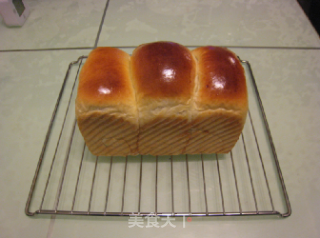Casida Super Soft Toast
1.
Put all the ingredients for making custard sauce into the small milk pot.
2.
Stir well with a whisk.
3.
Turn on a low heat and boil while stirring with a whisk until it becomes a paste. Take out and let cool, cover with plastic wrap, refrigerate for 60 minutes and set aside.
4.
Prepare all the ingredients for the main dough and take out the custard sauce from the refrigerator freezer.
5.
Put all the ingredients in the main dough except butter into the inner cylinder of the bread machine, in the order of liquid first and then solid. Place sugar and salt diagonally. Place milk powder and custard sauce diagonally. Dig a hole in the flour in the middle, add the yeast and cover it with flour.
6.
Turn on the dough mixing program of the bread machine. After a program (15 minutes), the dough is basically in a smooth state, put in softened butter, and start a dough mixing program again.
7.
After the third kneading procedure, the fourth kneading procedure was carried out for 10 minutes. Terminate the procedure, take a small piece of dough and slowly unfold it to show a large piece of glove-like film that is not easy to break to stop the kneading (actually 55 minutes for the dough)
8.
Take the dough out of the bread machine, reunite it, put it in the basin, and cover with plastic wrap.
9.
Low-temperature fermentation is carried out in an oven while monitoring the temperature with a thermometer.
10.
What the dough looks like after 60 minutes of fermentation. Suddenly, I had to go out for a temporary event, so I had to take out the dough and put it at room temperature (17 degrees).
11.
When I came back in the evening, the dough was fermented at room temperature for two and a half hours. After fermentation, the dough volume becomes 4 times the original. Dip the noodles with your fingers and insert a hole in the middle. The hole does not immediately retract and the surrounding noodles do not collapse, indicating that the degree of fermentation is just right.
12.
Take out the dough, vent it, weigh it, divide it into 3 evenly, and cover it with plastic wrap and let it rest for 15 minutes after it is rounded.
13.
Flatten the dough to exhaust, and roll it into an oval shape.
14.
After turning it over, roll it up from top to bottom and pinch the cuff tightly.
15.
Put the three dough rolls into the toast mold.
16.
Cover with plastic wrap and carry out secondary fermentation in the oven while monitoring the temperature with a thermometer. Put a bowl of hot water to maintain humidity.
17.
Ferment until the mold is nine minutes full (the temperature changes between 28-40 degrees, and the fermentation takes about 100 minutes to reach).
18.
Apply a layer of whole egg liquid evenly on the surface.
19.
After the oven is preheated at 200 degrees, the upper fire is 180 degrees, the lower fire is 190 degrees, and the bottom layer is baked for 30 minutes. If the second fermentation is successful, the bread will grow above the mold surface within 10 minutes of starting to bake. When the surface color reaches the desired color, cover the tin foil in time (according to past experience, my oven is very hard to heat, I both cover the tin foil and lower the heating temperature by 30 degrees).
20.
After being released from the oven, immediately demould and let it cool to room temperature, then seal it with a fresh-keeping bag for storage.


Tips:
1. High-gluten flour is the foundation of bread success. Sure enough, toast has to be a gold statue with a good reputation. The texture and toughness of the dough and after it is finished are different from the glutinous food I used before.
2. Basic fermentation is the key to bread success. I didn't use the bread machine today, I originally planned to use the oven for low-temperature fermentation to observe the effect. However, due to temporary conditions, the dough was first fermented in an oven at low temperature (28-40 degrees) for 60 minutes, and then at room temperature (17 degrees) for two and a half hours. The fermentation time was much longer than before. When the plastic wrap was uncovered, the chubby, swollen, and shiny appearance of the dough was really fascinating. Practice has proved that whether it is fermentation at low temperature in the oven or at room temperature, the effect is much better than the high-temperature fermentation in the bread machine.
3. The second fermentation is the guarantee for the success of bread. I didn't use a thermometer to monitor it during the previous second round. In fact, I only now know that the temperature of the oven was adjusted too high at that time, almost 50 degrees Celsius. Moreover, frequent replacement of hot water leads to too much moisture in the dough, so the secondary effect is always unsatisfactory. Practice has proved that using a thermometer to monitor the temperature between 28-40 degrees, the hot water in the oven can be replaced when the hot water is cold.
4. The leftmost peak of the toast is slightly shorter than the other two. The reason for the analysis may be that during the second fermentation in the oven, I put the toast box a little to the left (you can see the picture in step 16), because the right side needs to leave room for the water bowl and the thermometer. Probably the temperature on the left is low, so the degree of fermentation is different. The mold should be placed in the middle next time.